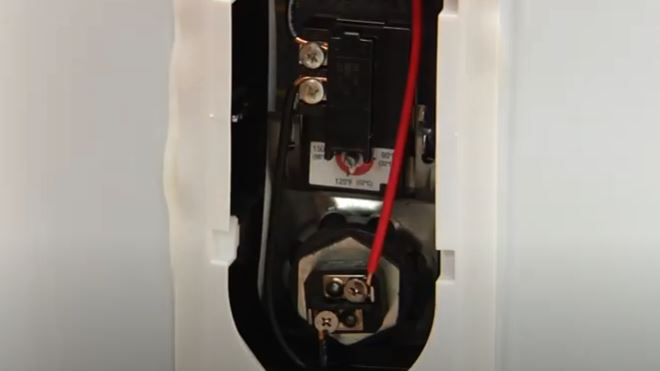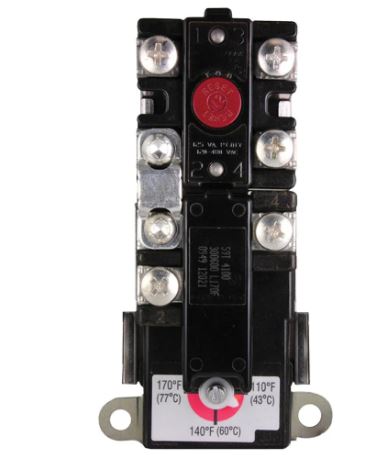A water heater reset button, also know as an emergency cut off (ECO) switch or high limit safety thermostat switch is a safety device that cuts off power to your water heater when the water temperature exceeds 180 degrees Fahrenheit.

Common Causes for the Water Heater Reset Button Tripping
- Overheating: The water inside the tank may become excessively hot, causing the high-limit switch to trip as a safety measure.
- Faulty Thermostat: A malfunctioning thermostat can inaccurately control the water temperature, leading to overheating and tripping the reset button.
- Sediment Buildup: Sediment accumulation at the bottom of the tank can insulate the heating element or burner, causing localized overheating and tripping the switch.
- Faulty Heating Element: A defective heating element can overheat, leading to the high-limit switch tripping.
- Electrical Issues: Wiring problems, short circuits, or electrical faults in the water heater’s components can cause the reset button to trip.
What to Do When the Water Heater Reset Button Trips
- Safety Precautions: Before addressing the issue, turn off the power supply to the water heater at the circuit breaker or disconnect the gas supply for safety.
- Allow Cooling: Let the water heater cool down for a few hours to reset itself. This can sometimes resolve the issue if it was triggered by temporary overheating.
- Check Thermostat Settings: Ensure the thermostat is set to a safe and recommended temperature, usually around 120°F (49°C). Avoid setting it too high.
- Drain and Flush Tank: If sediment buildup is suspected, drain and flush the water heater to remove accumulated sediments. This can improve the heater’s efficiency and reduce overheating.
- Inspect and Test Heating Elements: Examine the heating elements for signs of damage or malfunction. If a heating element is faulty, replace it with a compatible replacement.
- Check Wiring and Electrical Components: Inspect the wiring, electrical connections, and components for any loose connections, damaged wires, or electrical issues. Address any problems found during the inspection.
- Reset the Button: Press the reset button firmly to re-engage it. Listen for a clicking sound, which indicates that the reset button has reset.
- Restore Power or Gas Supply: After resetting, turn the power supply back on at the circuit breaker or reconnect the gas supply for a gas water heater.
- Monitor the Water Heater: Keep an eye on the water heater to ensure it’s functioning correctly. Check for consistent hot water supply.
Why Your Water Heater Keeps Tripping the Reset Button
Let us now look at why your water heater reset button keeps tripping in more details.
As mentioned above, a water heater reset button keeps tripping for 4 main reasons. These are:
1. A Bad Thermostat
A thermostat is a device installed on your water heater that monitors the temperature of the water inside it. When the temperature reaches the one you have set, it turns off the heating element.
An electric water heater has 2 thermostats and therefore 2 heating elements as well. The upper and lower thermostats are always in communication. If there is a problem with any of the thermostat it will affect the other one too
The reset button is usually installed on the upper thermostat. Power from the electrical outlet flows through the upper thermostat before flowing to the lower thermostat.
A malfunctioning thermostat will fail to turn off the power at the set temperature, causing the water temperature to raise to 180 degrees Fahrenheit. As designed, the rest button will trip, preventing the water temperature from rising any further.
Note: To prevent the water heater from bursting, it is usually fitted with a temperature and pressure (T&P) relief safety valve.
The signs of a bad water heater thermostat are when the reset button keeps tripping, followed by very hot water which cools off with time. When you have no hot water at all, it means the upper thermostat is bad while hot water followed by cold water signifies a bad lower thermostat.
2. Short Heating Element
As we have seen above, the thermostat is responsible for turning the heating element on and off. But what happens when there is a short in one of the heating elements?
The heating element will continue heating the water even after the thermostat has turned it off. The temperature of the water will continue increasing until the 1800 F level, when the reset button will trip.
Although the reset button is usually installed on the upper thermostat, it does not matter which heating element is short-circuited. This is because both the thermostats as we have mentioned are always in communication.
If therefore your water heater reset button keeps tripping, do not assume that either the upper thermostat or hitting element is bad. A bad lower heating element or thermostat will trip the water heater reset button as well.
3. Bad Reset Button
The water heater reset button itself can fail and start tripping even before the water temperature inside the water heater has reached its set temperature. If your water heater reset button keeps tripping while the water is not even hot enough, you could be dealing with a faulty reset button.
Failure in water heater reset button is usually caused by wear and tear as a result of overheating. A faulty rest button will fail to precisely monitor the water temperature inside the water heater and as a result it will trip even before the 1800 F water temperature setting is reached.
Since the reset button is part of the upper thermostat, you will also need to replace the upper thermostat if you establish that you are dealing with a bad reset button.
4. Loose Wiring
If your thermostat and heating element are working perfectly, the reason the reset button is constantly tripping could be a loose wire somewhere. But how does a loose electrical wire cause a water heater reset button to trip?
A loose electrical wire provides a lot of resistance, which generates heat. The reset button picks up the heat and trips, regardless of the water temperature inside the water heater.
For people whose houses use aluminum wiring while the water heater uses copper wiring, this could potentially cause the reset button to keep tripping.
For such a situation, a lug connector is usually installed where the 2 connections meet. Without a proper lug connector, the connection between the 2 different wirings can cause the water heater circuit breaker to trip.
This is a repair that you should have handled by a professional plumber or electrician.
Of the 4 causes above, I have observed that bad thermostats and short heating elements are the ones most responsible for water heater reset buttons that keep tripping.
Troubleshooting the Problem
So, how do you know whether your constantly tripping water heater reset button is caused by a bad thermostat or short heating element? You simply test for continuity in the heating element. To do that you will need to have a multimeter.
Here is how you do it:
- Start by turning off power to the water heater at the circuit breaker.
- Remove the thermostat cover panel. The panel is held in place using 2 screws. Use a Philips screwdriver to remove the screws. Since electric water heaters have 2 thermostats and heating elements, start off with the upper access panel.
- With the cover panel out, remove the insulation and put it aside. If there is a bracket and plastic cover over the thermostat remove them as well.
- Disconnect the heating element wires. The heating element wires are the 2 wires secured by the 2 screws under the thermostat.

- Check for continuity in the heating element. Set your multimeter to the continuity setting, preferably to the setting with a microphone sign. The multimeter will be beep incase of continuity. Position each of the 2 multimeter prongs on the 2 screws. If there is a beep, the heating element is good. On the other hand, if there is no beep, the heating element is bad and will need to be replaced.
- Move to the lower thermostat and heating element and repeat the same test.
A good heating element test often means that the problem is with the thermostat or reset button itself. In any case, both of them will need to be replaced.
How to Replace a Water Heater Thermostat

- After removing the cover plate, disconnect the thermostat wires.
- If you suspect you might forget where each wire was connected to, consider tagging them. Alternatively take a picture with your phone before disconnecting them
- Carefully remove the thermostat out of the retaining bracket, being careful not to break the retaining bracket. A broken retaining bracket means you will need to replace the entire water heater.
- Install the new thermostat and connect the wires back as they were.
- Adjust the temperature of the new thermostat to 1200 F.
- Put the insulation back and connect the cover panel as well.
- Turn on the power to the water heater.
Please note that the upper and lower water heater thermostats are not identical and cannot therefore be interchanged.
How To Replace a Water Heater Heating Element
- Turn off power to the water heater at the circuit breaker.
- Shut off the water heater cold water supply valve.
- Drain the water heater. Connect a garden hose to the drain valve and turn it on with a flathead screwdriver. Let the water drain out completely.
- Use a socket wrench (usually 1 ½ inch) to loosen the heating element connection on the water heater. When the connection is loose, unscrew it with your hand and pull out the heating element.
- Use a toothbrush to clean the connection threads.
- Slide in a washer in the new element (very important) and push the element inside the water heater. Screw it in until hand tight. Use the wrench to tighten it further.
- Confirm that the drain valve is fully closed.
- Turn on the cold water supply valve.
- To avoid air from being trapped inside the tank, open the nearest hot water faucet. As water fills the water heater, air will be flushed through the faucet. Turn off the faucet once air has been completely flushed out.
- Check that you have no leak around the heating element connection.
- Connect the wires back on the 2 screws and put back the insulation as well.
- Put the cover plate back on.
- Turn on the power.
If you are not very comfortable carrying out these type of repairs on your own, do not hesitate contacting a professional plumber to fix the water heater for you.
